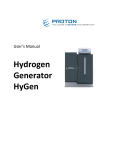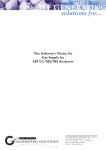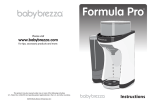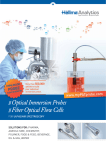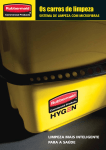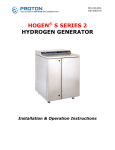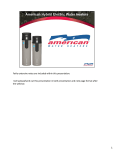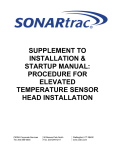Download The Stack - Masterflex
Transcript
User’s Manual The Stack PD‐0100‐0061 Revision A Table of contents_____________________________________ 1. Introduction________________________________________________________ _____3 2. Safety _________________________________________________________________4 3. Mechanical Assembly _____________________________________________________5 4. Communication ____ 5. Pneumatic Connections __________________________________________________11 6. Start‐Up Sequence _____________________________________________________13 _______________________________________________8 © 2010 – 2011 Proton Energy Systems, Inc. d/b/a Proton OnSite All rights not expressly granted herein are reserved. Information in this document is provided in connection with Proton Energy Systems Inc. d/b/a Proton OnSite (“Proton”) products and services. No license, express or implied, by estoppel or otherwise, to any intellectual property rights is granted by this document. Except as provided in Proton Terms and Conditions of Sale for such products and services, Proton assumes no liability whatsoever, and Proton disclaims any express or implied warranty, whether written or oral, relating to sale and/or use of Proton products or services including liability or warranties relating to fitness for a particular purpose, merchantability, or infringement of any patent, copyright or other intellectual property right. Proton products are not intended for use in medical, life saving, or life sustaining applications. Proton may make changes to specifications and product descriptions at any time, without notice. This document as well as any software, processes or procedures described in it is furnished under license and may only be used or copied in accordance with the terms of the license. The information in this document is furnished for informational use only, is subject to change without notice, and should not be construed as a commitment by Proton. Proton assumes no responsibility or liability for any errors or inaccuracies that may appear in this document or any software that may be provided in association with this document. Except as permitted by such license, no part of this document may be reproduced, stored in a retrieval system, or transmitted in any form or by any means without the express written consent of Proton. ® Proton, Proton OnSite, Proton Energy Systems, the Proton design, StableFlow, StableFlow Hydrogen Control System and design, HOGEN, and FuelGen are trademarks of Proton Energy Systems, Inc. Any other brands and/or names used herein are the property of their respective owners. 2 PD‐0100‐0061 Revision A 1. Introduction_________________________ This document gives basic instructions for the assembly of a stack of gas generators. The design of the gas generators allows up to four (4) units to be stacked, thereby saving valuable laboratory floor space. In addition, multiple generators can be controlled and monitored from a single operator interface. The following units can be stacked: Model Gas Generated AirComp Compressed Air NiGen GC / NiGen GC HC / NiGen GC MICRO Nitrogen AirGen GC / AirGen TOC Pure Air HyGen Hydrogen For information relating to technical specifications, intended use, safety and certification, refer to the respective generator manuals. With regard to installation and maintenance, it is assumed that the user is familiar with the use of pneumatic circuit components, and in particular is aware of the safety aspects of compressed air and nitrogen. The margin of the text contains the following symbols, indicating: Compulsory safety standards to be observed Electrical hazard L Recommendations and important information It is strongly recommended to carefully read all safety warnings before carrying out any operation on the generators. 3 PD‐0100‐0061 Revision A 2. Safety______________________________ L The Brezza generator stack must be assembled in compliance with the instructions given in this manual L Each generator must be installed and used in compliance with the instructions given in its user manual. Furthermore, the generators must only be used for the purposes given in Chapter 1 of their respective manuals. Failure to observe the foregoing will render the guarantee null and void and release PROTON ONSITE (“PROTON”) from all liability for direct or indirect damage or physical injury. L The user is responsible for asking local authorities if there are local safety regulations that are stricter than what is described in this manual. 2.1. Warnings______________________________________________ Place the Stack FAR FROM SOURCES OF HEAT Place the Stack in an environment PROTECTED AGAINST RAIN AND WIND Do not stack more than four (4) generators The Stack must be installed on a flat surface, at a slope of no more than 1° L 2.2. Repairs and inspections must be carried out exclusively by QUALIFIED PERSONNEL and/or the Proton Technical Service Team. Technical Service_________________________________ PROTON Technical Service can be contacted as follows: Proton OnSite 10 Technology Drive Wallingford, CT 06492 203‐949‐8697 203‐678‐2000 [email protected] www.protononsite.com 4 PD‐0100‐0061 Revision A 3. Mechanical Assembly _________________ 3.1. Stack Configuration ______________________ The Stack may be composed of 2, 3, or 4 generators. If an AirComp unit is present, it must go at the bottom of a Stack. If a HyGen unit is present, it must go at the top of a Stack. L Figure 3.1 gives an example of a Stack configuration. Figure 3.1 5 PD‐0100‐0061 Revision A 3.2. Mechanical Assembly_____________________________ 3.2.1. Position the Base • The surface where the stack is installed must be level (maximum incline ± 1°). 3.2.2. Secure the Bottom Generator • Use two screws supplied with the generator to secure the rear of the enclosure to the rear of the base. Reference Figure 3.2.2 B. 3.2.3. Secure the Remaining Generators • • Remove the front panel. Use two pins and two mounting tabs supplied with the generator to secure the front base of the enclosure to the top front of the enclosure underneath. Insert the pins into the mounting tabs. Use the holes pre‐drilled into the enclosure top and bottom. Reference Figure 3.2.2 A. • Use two screws supplied with the generator to secure the rear of the enclosure to the rear of the base. Reference Figure 3.2.2 B. Figure 3.2.2 A Figure 3.2.2 B 6 PD‐0100‐0061 Revision A 3.2.4. Mounting the Operator Interface • Locate the Operator Interface bracket onto the top generator enclosure. Orient in line with the holes on top of the enclosure. Secure the bracket to the enclosure with two screws supplied with the generator. Reference Figure 3.2.4. • Figure 3.2.4 7 PD‐0100‐0061 Revision A 4. Communication ___ When configured properly, multiple generators can be controlled by a single operator interface. 4.1. Connections Using the RJ45 ethernet cables supplied with each generator, connect the operator interface to each generator. Reference Figure 4.1 for connection details. 1. Connect the top port of the operator interface to the CAN BUS IN port of the nearest generator. 2. Connect the CAN BUS OUT port of the previous generator to the CAN BUS IN port of the next generator in the stack. Continue this step until the last/bottom generator is reached. 3. The bottom generator is considered the “End of Line” generator and it will only have an RJ45 ethernet cable terminated to its CAN BUS IN port. 8 PD‐0100‐0061 Revision A Figure 4.1 9 PD‐0100‐0061 Revision A 4.2. Generator Addressing___________________________ In order to communicate to the operator interface, each generator must be assigned its own unique address. To set a generator’s address, adjust the DIP switches on the back of each generator panel. The DIP switches are located between the CAN BUS IN and CAN BUS OUT ports. Reference Figure 4.2 for address assignments L NiGen, AirGen and AirComp generators have 4 DIP switches; HyGen generators have 6 DIP switches. Figure 4.2 The leftmost DIP switch determines whether the generator is an “end of the line” unit. The “end of the line” unit is the generator furthest from the CPU. If the generator is an “end of the line” unit (or if it is a single generator) set the leftmost DIP switch to the up position (H); otherwise set it to the down position (L). 10 PD‐0100‐0061 Revision A 5. Pneumatic Connections_____________ To connect facility compressed air to NiGen or AirGen generators, use piping and fittings rated to operate at the maximum pressure to be supplied by the compressed air source. 5.1. Configuration________________________________ L • • • • In the event the compressed air source is an AirComp generator, one (1) AirComp generator can support the compressed air needs of: 1 NiGen Micro generator OR Up to 3 NiGen GC generators OR Up to 2 AirGen generators OR 1 NiGen GC generator + 1 AirGen generator To connect the AirComp to the other generators, use the quick disconnect fittings and flexible tubing provided with each generator. Reference Figure 5.1 as an example of pneumatic connections for a stack. 11 PD‐0100‐0061 Revision A Figure 5.1 12 PD‐0100‐0061 Revision A 6. Start Up Sequence___________________ L • • • In order to avoid generator communication errors, the following start up sequence is recommended: Power up the first generator – the generator connected directly to the operator interface. Power up the generator connected directly to the first generator. Proceed with the remaining generators until the last generator (the generator “furthest” from the operator interface) has been powered up. 6.1. Operator interface________________________________ TOUCH SCREEN The Operator Interface Touch Screen enables the user to interact with the generators in the stack. In addition to the ability to give specific commands and set parameters, the operator interface also provides system status including the annunciation of warnings and alarms. Figure 6.1 provides a navigation menu for maneuvering through the operator interface. Reference the specific generator manual for more detailed information. 13 PD‐0100‐0061 Revision A Figure 6.1 14 PD‐0100‐0061 Revision A Proton OnSite 10 Technology Drive Wallingford, CT 06492 203‐678‐2000 203‐949‐8697 www.protononsite.com 15















